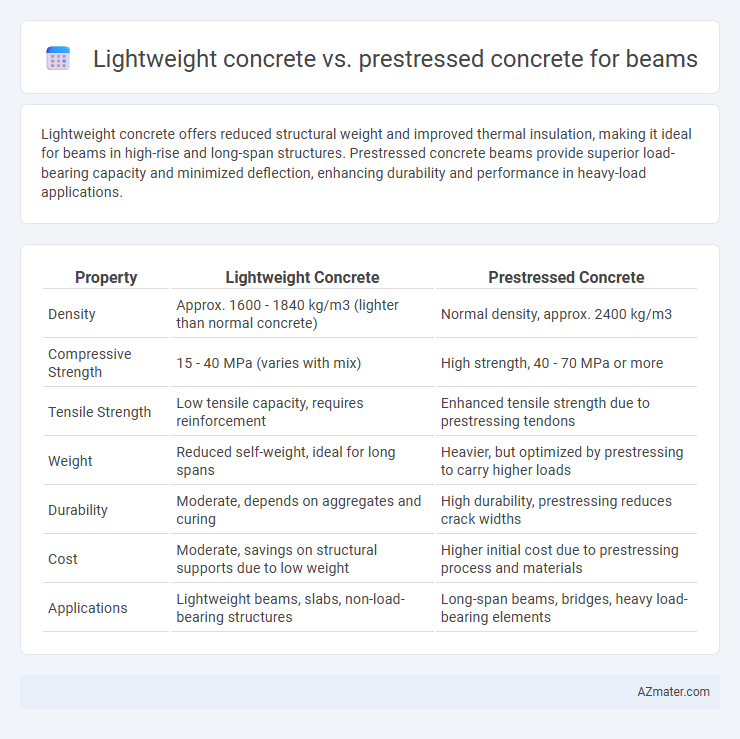Lightweight concrete offers reduced structural weight and improved thermal insulation, making it ideal for beams in high-rise and long-span structures. Prestressed concrete beams provide superior load-bearing capacity and minimized deflection, enhancing durability and performance in heavy-load applications.
Table of Comparison
| Property | Lightweight Concrete | Prestressed Concrete |
|---|---|---|
| Density | Approx. 1600 - 1840 kg/m3 (lighter than normal concrete) | Normal density, approx. 2400 kg/m3 |
| Compressive Strength | 15 - 40 MPa (varies with mix) | High strength, 40 - 70 MPa or more |
| Tensile Strength | Low tensile capacity, requires reinforcement | Enhanced tensile strength due to prestressing tendons |
| Weight | Reduced self-weight, ideal for long spans | Heavier, but optimized by prestressing to carry higher loads |
| Durability | Moderate, depends on aggregates and curing | High durability, prestressing reduces crack widths |
| Cost | Moderate, savings on structural supports due to low weight | Higher initial cost due to prestressing process and materials |
| Applications | Lightweight beams, slabs, non-load-bearing structures | Long-span beams, bridges, heavy load-bearing elements |
Introduction to Lightweight and Prestressed Concrete
Lightweight concrete is designed with low-density aggregates to reduce the overall weight of the beam, improving structural efficiency and ease of handling. Prestressed concrete incorporates high-tensile steel tendons tensioned before or after casting to enhance load-bearing capacity and control deflection. Both materials offer distinct advantages in beam construction, with lightweight concrete prioritizing weight reduction and prestressed concrete focusing on increased strength and durability.
Material Composition and Properties
Lightweight concrete for beams incorporates lightweight aggregates such as expanded clay, shale, or pumice, resulting in reduced density and improved thermal insulation, with typical densities ranging from 1400 to 1900 kg/m3. Prestressed concrete beams utilize high-strength steel tendons tensioned before or after casting, combined with normal-weight concrete to enhance load-carrying capacity and control tensile stresses, typically achieving compressive strengths between 40 to 60 MPa. The material properties of lightweight concrete emphasize reduced dead load and enhanced fire resistance, while prestressed concrete offers superior structural performance through increased flexural strength and crack control.
Structural Performance Comparison
Lightweight concrete beams exhibit reduced self-weight, which decreases dead load and enhances seismic performance, but they generally possess lower compressive strength and stiffness compared to prestressed concrete beams. Prestressed concrete beams achieve higher load-carrying capacity and improved crack control due to induced pre-compression, resulting in superior flexural strength and durability under heavy loads. The choice between the two depends on project requirements, where lightweight concrete is preferred for reduced weight and thermal insulation, while prestressed concrete excels in structural performance for long-span and high-load applications.
Weight and Load-Bearing Capacity
Lightweight concrete beams significantly reduce overall structural weight, easing transportation and handling while maintaining adequate strength for moderate loads. Prestressed concrete beams enhance load-bearing capacity by applying compressive stresses, allowing them to support heavier loads and longer spans with reduced size and material use. Choosing between the two depends on project requirements, with lightweight concrete favoring weight efficiency and prestressed concrete optimizing strength and durability under high loads.
Durability and Longevity
Lightweight concrete beams offer improved durability due to reduced density, minimizing dead load and enhancing resistance to seismic forces and freeze-thaw cycles. Prestressed concrete beams demonstrate superior longevity by effectively controlling tensile stresses, reducing crack formation and enhancing resistance to corrosion of reinforcing steel. Combining lightweight materials with prestressing techniques optimizes beam performance, extending service life in demanding structural applications.
Construction Techniques and Methods
Lightweight concrete beams utilize air-entrained or lightweight aggregates, reducing structural weight and simplifying formwork handling during construction, which accelerates installation and improves thermal insulation. Prestressed concrete beams employ high-tension steel tendons pre-tensioned or post-tensioned to enhance load-bearing capacity and control cracking, requiring precision in stressing techniques and specialized equipment for tensioning and anchorage. Construction methods for lightweight concrete emphasize mixing and placing procedures to maintain uniform density, while prestressed concrete demands accurate tendon placement and tensioning sequences to achieve designed prestress levels and structural performance.
Cost Analysis and Economic Viability
Lightweight concrete beams typically reduce dead load, leading to savings in foundation and structural support costs, but may have higher material expenses compared to conventional concrete. Prestressed concrete beams involve increased initial costs due to specialized materials and labor; however, their enhanced load capacity and durability can lower long-term maintenance and lifecycle costs. Economic viability depends on project scale, load requirements, and service life expectations, with lightweight concrete favored for cost-sensitive, low to medium load applications and prestressed concrete optimal for high-strength, long-span structural needs.
Applications in Beam Construction
Lightweight concrete beams are commonly used in building floors, bridges, and high-rise structures where reducing dead load is essential for design efficiency and seismic performance. Prestressed concrete beams are preferred in long-span bridges, parking structures, and industrial buildings due to their superior ability to carry heavy loads and resist tensile stresses through pre-applied tensioning of steel tendons. Both materials enhance structural performance, with lightweight concrete optimizing weight reduction and prestressed concrete maximizing load-bearing capacity.
Sustainability and Environmental Impact
Lightweight concrete offers reduced material usage and lower transportation emissions due to its decreased density, significantly contributing to sustainability by minimizing the carbon footprint of beam construction. In contrast, prestressed concrete enables longer spans and thinner beams, optimizing material efficiency and reducing overall resource consumption, thus enhancing environmental performance. Both materials support sustainable building practices by improving energy efficiency during production and construction, with prestressed concrete often leading to lower lifecycle emissions through structural optimization.
Summary and Recommendation
Lightweight concrete offers reduced self-weight, improved fire resistance, and better thermal insulation for beam construction but generally exhibits lower strength and higher cost compared to prestressed concrete. Prestressed concrete provides superior load-carrying capacity, enhanced durability, and minimized deflection, making it ideal for long-span beams and heavy-load applications. For optimal structural performance, prestressed concrete is recommended when high strength and load resistance are critical, while lightweight concrete suits applications prioritizing weight reduction and energy efficiency.

Infographic: Lightweight concrete vs Prestressed concrete for Beam
 azmater.com
azmater.com